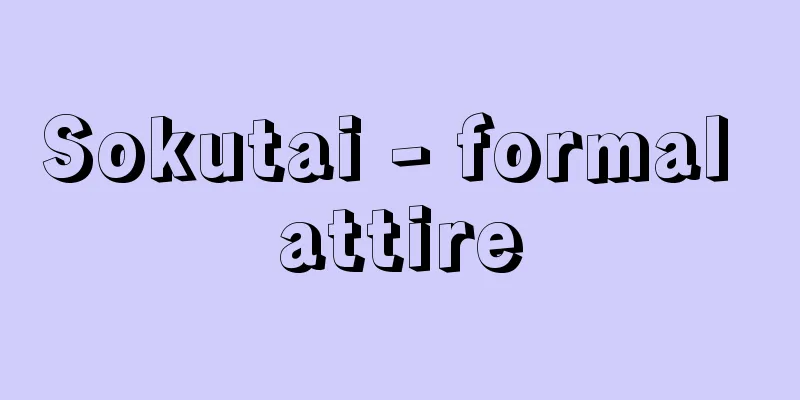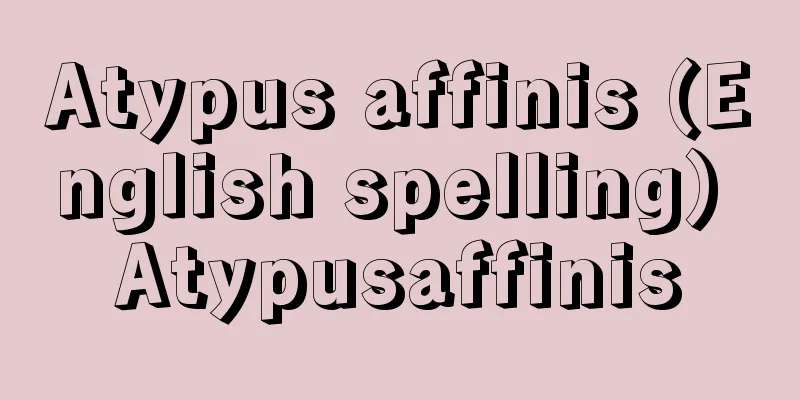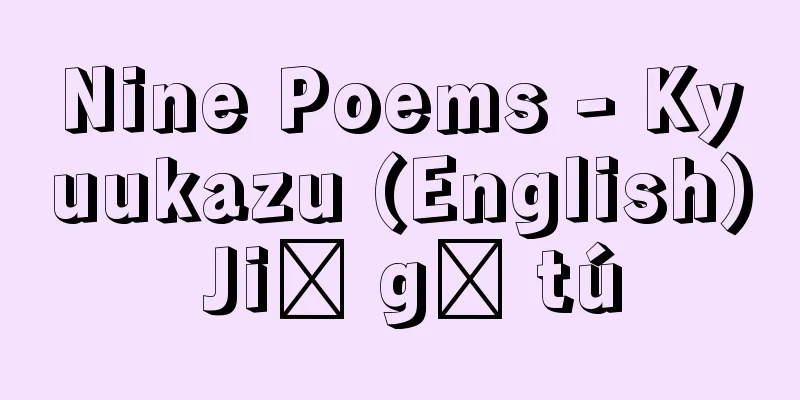Sokutai - formal attire

|
Formal attire for male nobles. Worn by those who hold official positions in the Imperial Court. Ceremonial attire, as stipulated in the Yoro Clothing Order, was to be worn during ceremonies, but in the Heian period it was only used for enthronement ceremonies, and the morning clothes worn when visiting the Imperial Court took the place of formal attire and were used for ceremonies as well, coming to be called sokutai. The name is said to come from the passage "Sokutai stands at the court" in the Gongye Chang Chapter of the Analects of Confucius. The first appearance of the sokutai was in the "Saigūki" (Record of the Western Palace), but it is not found in the "Engishiki" (Ceremonial Book of the Imperial Court). In the section on the Nuido-ryō (Ceremonial Office) and the section on annual clothing, the robe, sliding screen, half-sleeved trousers, sweat robes, akome, outer hakama, middle hakama, and loincloth, which are thought to be the morning clothing of the emperor, are listed, suggesting the trend toward the sokutai. From the traditional Chinese-style clothing imported directly from Japan, the clothing adapted to the Japanese climate and environment and became more Japanese, and became longer and more straight-cut, which led to the development of the very elegant and elegant style of the morning clothing. The sokutai was worn for ceremonies and events as a formal attire, and was also called "hino-sozoku" (day attire) because it was used during the day. Therefore, it is distinguished from the casual attire such as the cloth hakama and crown worn by night watchmen. Samurai of the Shogun and above the fifth rank also wore it on important occasions. The sokutai consisted of a crown, a robe, half-arm, a shigasane (undergarment), an akome (robe), a hitoe (single layer), an omote hakama (front trousers), an oguchi (front trousers), a sekitai (sash), a fish bag (fish bag), a shitouzu (trousers), sandals (footwear), a scepter (scepter), a hiogi (folding fan), and a tatou (paper envelope). There was a distinction between sokutai for civil servants, military officials, and children. Civil servants wore a robe with a brocade or a robe with a sewn armpit, and usually did not wear a decorated sword, but those of higher rank who had received imperial permission wore a ceremonial sword with a flat cord (hirao). Military officers roll up the strings of their crowns to make what is called a "wrapped string," and then tie the cords with strings attached to them around their crowns under their chins. They then wear a jacket called a "no-brocade robe" or a "ketteki robe," which is open at the sides and does not have to be sewn together, and carry a sword of the Imperial Guard called a "tweezers-shaped sword." They carry bows and arrows, and wear a "yanagui" (a sash) on the back of their waist to store their arrows. Ceremonial officers wear a tsutsugi-style hakama over their robe, a belt called a "sebie" around their waist, and decorative armor called a "keikou." Kugyo of the third rank or higher who held both military and civilian positions wore sewn underarm robes, except when in ceremonial guard duty. Therefore, they were not wrapped around the neck, but hung with a hanging cord, and no cord was attached. Military officials of the sixth rank or lower wore a crown called a saiei, a simplified version of a wrapped cord with only the edges made into a loop, which was also attached with a cord. A cord was attached to this as well. The cord was stipulated in the Clothing Law, but its form is unclear, and it is thought to have been used for convenience of movement and to show dignity. From the late Heian period onwards, the cord was made by arranging horse buttocks in a radial pattern to form a semicircle, which was attached to the cord attached to the crown and placed over both ears. Young boys wore a mizura, a style of hair that was parted and tied on both sides of the face, so they did not wear a crown, but wore a robes without a hanging cord. The color of the robe worn by the sokutai (ceremonial court robes) is determined by rank, and is called 'Iho'. In other words, it follows the color of the robe, and this is also basically based on the Clothing Law. However, since 806 (Daido 1), there have been some changes, and those of the third rank and above all wore deep purple, regardless of whether it was deep or light, and those of the fourth rank and below wore deep crimson, deep green, and deep indigo, respectively. Also, from 820 (Kōnin 11), Emperor Saga wore robes of yellow lacquer dye in addition to white, the former for rituals and the latter for official occasions. In addition, blue-and-white oak, blue, or a grayish yellow-green robe called kikujin was worn for ceremonies. Furthermore, in the 10th century, deep purple changed to black, and the fourth rank also wore black, while all those below the sixth rank wore green. The robes of the sixth rank were also called green robes, but these greens had actually become indigo blue since the 12th century. The hanbi worn under the robe is a vest with very narrow sleeves and brocade at the hem, but from the mid-Heian period onwards, the sleeves were removed. From the end of the Heian period onwards, it was omitted when wearing a robe with sewn armpits. The shita-gasame is an inner garment worn under the hanbi or directly under the robe, with the back hem also called the shiri. It gradually became longer, and except for those of the Emperor, Crown Prince and Imperial Prince, the hem was separated from the back body and changed to a style where it hung separately from the waist, and was called bekkyo. The komi used with sokutai was red in colour, and in summer it was made of hitoe (single layer) and called hiegi (double layer). Hitoe was also set to be red in colour, and was made of hitoe (single layer) in both summer and winter. The omote hakama is a front-opening hakama, and since 690 (the 4th year of the reign of Empress Jitō) it has been decided that white hakama should be worn as morning attire, this has been adhered to, with a white outer layer and a red lining. The ooguchi is a four-panel under-hakama, side-opening, and red, although elderly people sometimes wear white. The ishi-obi is a leather belt worn over the robe, with a decorative jewel or stone called ka attached to the part that touches the back of the waist. There are several types of sandals, but asagutsu are worn for everyday use, ka for ceremonies, mikutsu for rainy and muddy days, and half-shoes for horseback riding. Shikai are sandals with an instep and heel made of woven silk thread, and are used for child-like or bugaku costumes. When putting on the sandals, shizuri are worn. Shizuri are socks, and are made of white plain silk. The shaku (stick) is said to have originated from the practice of writing the order of ceremonies on a stick as a reminder, and later became a tool for maintaining proper etiquette. Choshi (paper to write poetry) is also commonly called kaishi (paper to hold a person's hand) and was used for writing poetry and as tissue paper. Hiogi (folding fan) is made from thin planks of straight-grained cypress wood, and a set contains 25 to 27 sheets. Children use what are called horizontal grain fans made from cedar planks. The uobukuro (fish bag) is a fish-shaped ornament that is attached to the right side of a stone belt by persons of fifth rank or higher during ceremonies; it was originally called a uofu (fish charm) and is believed to have been used as a gate mirror. The texture, color, and pattern of the sokutai, as well as the robe, are determined by rank, but for those accompanying the Emperor on a non-major occasion called Ichinichibare, they are allowed to wear whatever clothes they like other than the robe for just one day, and this is also called somesozoku. In addition, when the undergarment and below are all white, this is called shira-kasane or shiro-sozoku, and is worn on the day of changing clothes. Among Bugaku costumes, Ninchō-no-mai, Kume-mai, Azuma-asobi, Hira-mai, and Ban-e-sozoku are either sokutai or variations of it. [Takada Yamato] ©Minoru Sugai formal attire Source: Shogakukan Encyclopedia Nipponica About Encyclopedia Nipponica Information | Legend |
|
公家(くげ)男子の正装。朝廷の公事に位を有する者が着用する。養老(ようろう)の衣服令(りょう)に規定された礼服(らいふく)は、儀式のときに着用するものとされたが、平安時代になると即位式にのみ用いられ、参朝のときに着る朝服が礼服に代わって儀式にも用いられ、束帯とよばれるようになった。この名称は『論語』の公冶長篇(こうやちょうへん)の「束帯立於朝(そくたいにしてちょうにたつ)」より出たといわれている。束帯の初見は『西宮記(さいぐうき)』で、『延喜式(えんぎしき)』にはみられないが、その縫殿寮(ぬいどのりょう)の条、年中御服の項に、天皇の朝服とみられる袍(ほう)、襖子(おうす)、半臂(はんぴ)、汗衫(かんさん)、(あこめ)、表袴(うえのはかま)、中袴、褌(したばかま)などが掲げられていて、束帯への動向をうかがわせる。従来の中国風で直輸入的な服装から、日本の気候風土に順応し、生活に適合するものとなって、和様化が進み、衣服の長大化と直線裁式に戻ることによって朝服が非常に優雅典麗な形式に発展した。束帯は儀式や行事などに着装して晴装束とし、また昼間に用いられるもののため昼(ひの)装束ともよばれた。したがって宿直(とのい)装束の布袴(ほうこ)や衣冠(いかん)のごとき略装と区別される。 武家も将軍以下五位以上の者は大儀に際して着用した。束帯の構成は冠、袍、半臂、下襲(したがさね)、袙(あこめ)、単(ひとえ)、表袴、大口(おおぐち)、石帯(せきたい)、魚袋(ぎょたい)、襪(しとうず)、履(くつ)、笏(しゃく)、檜扇(ひおうぎ)、帖紙(たとう)よりなる。束帯に文官用と武官用、および童形用の区別がある。文官は、有襴(うらん)の袍または縫腋(ほうえき)の袍とよばれる上着を着て、通常は飾太刀(かざりたち)を佩(は)かぬが、勅許を得た高位の者は儀仗(ぎじょう)の太刀(たち)を平緒(ひらお)によって帯びる。武官は冠の纓(えい)を巻き上げて、いわゆる巻纓(けんえい)とし、緌(おいかけ)をつけた緒を冠にかけてあごの下で結んで留める。そして無襴の袍または闕腋(けってき)の袍といわれる、両脇(わき)を縫い合わせずにあけた上着を着て、毛抜形と称される衛府(えふ)の剣(たち)を佩く。弓箭(きゅうせん)を携え、箭(や)を収める具として胡籙(やなぐい)を後ろ腰に帯びる。儀仗の武官は、袍の上に貫頭衣式の裲襠(うちかけ)をかぶり、腰に摂腰(せびえ)といわれる帯を締め、また装飾的な挂甲(けいこう)という鎧(よろい)をつけた。三位以上の公卿(くぎょう)で武官と文官を兼任する者は、儀仗の際を除いて縫腋の袍を着用した。したがって巻纓ではなく垂纓で、緌はかけない。六位以下の武官の冠には、細纓(さいえい)といって、巻纓を簡略化して纓の縁のみ輪奈(わな)にしたものをつけた。またこれにも緌をかける。緌は衣服令に規定されているが、その形式については明らかではなく、行動の便と威儀を示すために用いられたと思われ、平安時代後期以後の形式は、馬の尻毛(しりげ)を放射状に並べて半円形とし、冠にかける緒につけて両耳のところに当てた。少年は、みずらといって、髪を顔の両側に分けて束ねる形のため、冠をかぶらず、闕腋の袍を着る。 束帯の袍は、位袍といって位階により服色が決められている。すなわち当色に従うもので、これも基本的には衣服令によっている。しかし、806年(大同1)以来、若干の変化をみせ、三位(さんみ)以上の者の紫は深浅の区別なく、みな深紫となり、四位以下もそれぞれ深緋(あけ)、深緑、深縹(はなだ)となり、また820年(弘仁11)より、嵯峨(さが)天皇は白のほか黄櫨染(こうろぜん)の袍を用い、前者は祭祀(さいし)のとき、後者は公事の場合に着装した。そのほか青白橡(あおしろつるばみ)、青色(あおいろ)、あるいは麹塵(きくじん)ともいわれる灰色みがかった黄緑色の袍を行事に用いた。さらに10世紀には深紫が黒に変わり、四位も黒を用い、六位以下はみな緑となって、六位の袍を緑衫(ろうそう)とも称したが、これら緑は、12世紀より実際は縹色となっている。 袍の下に着る半臂は袖(そで)幅のごく狭い袖をつけた胴衣で、裾(すそ)に襴がついているが、平安時代中期以後は袖を除いた形となった。平安末期以降、縫腋の袍を着るときは省略された。下襲は半臂または直接袍の下に着る内衣で、後ろの裾を尻(しり)ともいい、しだいに長いものとなって、天皇、皇太子、親王のもの以外は後ろ身頃(みごろ)から裾を切り離して、別に腰から垂らす形式に変えて別裾(べっきょ)と称した。束帯に用いられる衵は紅色とされ、夏季は単(ひとえ)仕立てで比倍木(ひえぎ)とよんだ。単も紅色と定められ、夏冬とも単仕立ての衣である。表袴は、前開き式の袴で、690年(持統天皇4)に朝服に白袴と定められて以来それを守り、表地を白、裏地を紅としている。大口は下袴で四幅(よの)仕立て、側開式となっており紅色と決められ、ときに老人が白を用いる。石帯は袍の上から締める革の帯で、後ろ腰に当てる部分に銙(か)という飾りの玉や石をつけたもの。履は数種のものが用いられるが、浅沓(あさぐつ)は平常に、靴(か)は儀式に、深沓は雨泥の日に、半靴は乗馬に用いられた。絲鞋(しかい)は絹糸を編んで甲と踵(きびす)にした沓で、童形、あるいは舞楽装束に使われる。履をはくときに襪をはく。襪は靴下のことで白平絹でつくられる。笏(しゃく)は、儀式のとき式次第を備忘のため笏に記したことから始まるとされ、のちに威儀を正すための具となった。帖紙は俗に懐紙(かいし)ともいわれ、詩歌を書いたり鼻紙としても用いられた。檜扇は檜(ひのき)の柾目(まさめ)の薄板でつくられ、25枚から27枚ほどを一組としている。童は杉の板目を使った横目扇といわれるものを用いる。魚袋は、儀式のとき五位以上の者が石帯の右側につけて垂らす魚形の飾りで、もとは魚符といわれ、門鑑として用いられたものとされている。 束帯は袍以下、位階により地質、色目、文様が定められているが、一日晴(いちにちばれ)といって大儀でない行幸の供奉(ぐぶ)などに、その当日1日だけ、袍以外の衣服に好みのものを用いて着飾ることを許され、これを染(そめ)装束ともよんだ。そのほか、下襲以下、すべて白一色としたものを、白(しら)重ねまたは白(しろ)装束と称し、更衣(ころもがえ)の日に着用した。舞楽装束のうち、人長舞(にんちょうのまい)、久米(くめ)舞、東遊(あずまあそび)、平舞(ひらまい)、蛮絵装束などは、束帯ないしその変化形式である。 [高田倭男] ©須貝 稔"> 束帯 出典 小学館 日本大百科全書(ニッポニカ)日本大百科全書(ニッポニカ)について 情報 | 凡例 |
Recommend
Share-cropping (English)
…Therefore, this tenant system is often seen in t...
Cornelis van Vollenhoven
1874‐1933 Dutch legal scholar and founder of Indon...
Hisatada Otaka
Conductor and composer. Born in Tokyo. He went to...
Penetration
A Japanese term for the cracks that appear on the...
Mining disease - Kozanbyo
Historical name for various diseases suffered by m...
Ammophila atripes japonica (English spelling) Ammophilaatripesjaponica
…[Shiro Katsuya]. . . *Some of the terminology th...
Count of Artois - Artois
…Brother of Louis XVI and Louis XVIII. Before his...
Hermann I
...The next prince, Louis the Pious, accompanied ...
exclusionist
…However, since parolees, as well as prisoners wh...
Green pigeon lice - Green pigeon lice
…The female only gives birth to one larva at a ti...
Meteorological disasters
This refers to disasters caused by fluctuations i...
Glyptostrobus
...This is probably due to the extinction of spec...
Olynthos (English spelling)
An ancient Greek city on the Chalcedic peninsula, ...
chemical reagent
...A general term for chemicals for testing and r...
Sanhedrin
The highest deliberative and decision-making body ...









![Tokorozawa [city] - Tokorozawa](/upload/images/67cc56b9093f5.webp)